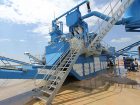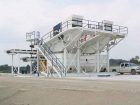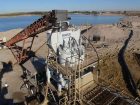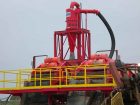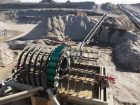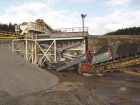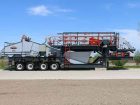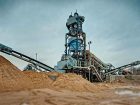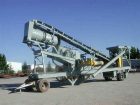
Products & Equipment
Pits & Quarries
Focus on washing equipment
The latest washing equipment for aggregate operations.
September 26, 2016 By Rock to Road Staff

September 26, 2016 – The latest washing equipment for aggregate operations.
Classifying tanks
Designed to remove large volumes of excess water from feed material, Eagle Iron Works (EIW) Classifying Tanks smooth out feed fluctuations and remove excess sand particles for a consistent in-spec product. Recently, the MARK VI computerized sand re-blending control system was introduced for this equipment. It makes stockpile calibration easier and faster, allowing for a varying number of controlled products, as well as calibrated tons per hour forecast of the products produced. Producers using the MARK VI system maintain tighter control of their products’ Fineness Modulus (F.M.). It can handle up to two tanks simultaneously and makes calibration simple, fast and easy.
www.eiwllc.com
Wash screens
Elrus Aggregate Systems wash screens have been developed with more than 40 years of industry experience, and design evolution. They feature heavy-duty side panel and carry deck construction, rotated cross tubes to maximize screen open area, integral wash bars and easily replaceable inlet chutes and discharge lips. Available in a range of sizes from
3’ x 6’ to 8’ x 20’, Elrus can custom design or configure to meet individual requirements.
www.elrus.com
Bucket wheel
The Phoenix/KISA Bucket Wheel is designed for the capture, de-sliming, and dewatering of sand and gravel slurries. These machines are uniquely designed for solids recoveries of 99 per cent, including dilute slurries such as dredger spoil, all while operating with very low power requirements. Dewatered solids are readily conveyable and stackable, having residual moistures that are considerably lower than dewatering screws.
www.dewater.com
Mobile washing plant
The CDE M4500 integrates feeding, screening, sand washing and stockpiling up to five products onto one chassis. This mobile washing plant has a capacity of 450 tons per hour and is part of a suite of modular equipment, which ensures ease of integration, rapid deployment and minimal footprint. The company’s modular equipment range also ensures that future changes to a customer’s requirements in relation to capacity or final product specifications can be easily accommodated ensuring the CDE plant can evolve with one’s business.
www.cdeglobal.com
Portable wash plant
Rock Systems Portable Wash Plant and Placer Gold Recovery Plant come complete with a 9’ x 6’ feed hopper with self-cleaning grizzly with bars spaced at 4” openings; 24” wide x 7’ long roller belt feeder with variable speed drive and adjustable discharge gate; 24” wide main feed conveyor with full length skirtboards; 42” diameter x 8’ long rotary scrubber with water spray pipe; 3’ wide x 6’ long double deck vibrating screen with punched plate on the top deck with 2” round openings and screen cloth on the bottom deck with 1/4” x 1/2” slotted openings; 24” wide side discharge conveyor for the oversize material from both decks of the screen; 44” wide x 48” long pulsating rougher jig with steel shot; 44” wide x 8’ long sluice box; 12” diameter stand pipe; tandem axle chassis with dual wheels, stabilizing jacks, brakes, lights and fifth wheel pin; self-contained with an Isuzu diesel generator. Includes finishing jig with sump and pump.
www.rocksystems.com
Ultra Sand Plants
McLanahan Ultra Sand Plants help producers increase sand production, produce a drier product and improve product consistency. Ultra Sand Plants combine separators, dewatering screens and a slurry pump to provide a three to five per cent higher product yield over traditional fine material screw washers. Typically fed by a wash screen’s bottom deck discharge, Ultra Sand Plants operate efficiently, sending unwanted fines to waste streams and keeping product sized fines in the product piles. Material is typically fed directly onto a dewatering screen, allowing screen media to separate the coarse fractions from the water and fine stand fractions. Any material that passes through the screen area is pumped to a cyclone or separator where sand classification occurs. They also have the ability to separate and combine sand fractions, allowing users to blend coarse/fine sands as needed to meet product specifications. Unwanted silts and fines are removed, while the product-sized fines are discharged back to the dewatering screen to remove additional moisture.
www.mclanahan.com
Washing station
Terex Washing Systems’ AggreSand is a highly versatile, integrated washing station with outstanding performance capability across a wide range of materials and the ability to offer up to five washed and sized products. Its readily portable format makes it particularly suitable for green-field applications, contractor use and temporary planning permission sites; but operators more used to static installations will still appreciate the small footprint and minimal site preparations required. It offers numerous modular configurations but all are based around the choice of a 16’ x 5’ or 20’ x 6’ washing screen and a choice of sand output capacities. It offers up to three washed aggregates and two washed sands; a modular design with plug and play electrical connections for quick set-up; it is pre-wired and pre-plumbed with single connection points; has an automated touchscreen control providing all-round plant information; a choice of grid and screen media options to suit your application; intelligent low level and easy access features for maintenance and wash down; and it is transportable in four to six containers.
www.terex.com/washing-systems
Washing system
Haver & Boecker’s Hydro-Clean washing system effectively cleans deleterious material from aggregates and minerals while reducing water consumption. Taking feed material as large as six inches (150 millimeters) into its vertical drum, the Hydro- Clean employs high-pressure nozzles, rotating at 90 rpm, to spray as much as 90 per cent recycled water on the material with pressures as high as 2,000 psi (140 bars). The washing system removes silt and clay particles as small as 63 microns from mineral mixtures. The washer comes in three model sizes — the HC350, HC1000 and HC2000 — that process 18 to 360 tons per hour, depending on the model and application.
Water consumption ranges from 27 to 211 gpm, depending on application and model size.
www.havercanada.ca
Portable screen and wash plants
Superior Industries has launched a set of standard designs for its portable processing plants including a Guardian Screen Plant, Twin Screw Wash Plant and Aggredry Wash Plant. The standard features are designed to speed setup and improve processing efficiencies. The Guardian Horizontal Screen is a triple shaft, horizontal screen, which offers unique features like bottle-jack lifting points for spring replacement, fully-enclosed belt guards with integrated tensioning systems and hinged doors for easy screen inspection. Designed to integrate a fine material washer and dewatering screen into a single component, sand processed through an Aggredry Washer has moisture content of eight per cent. The product requires no drying time and is instantly saleable.
www.superior-ind.com
Print this page
